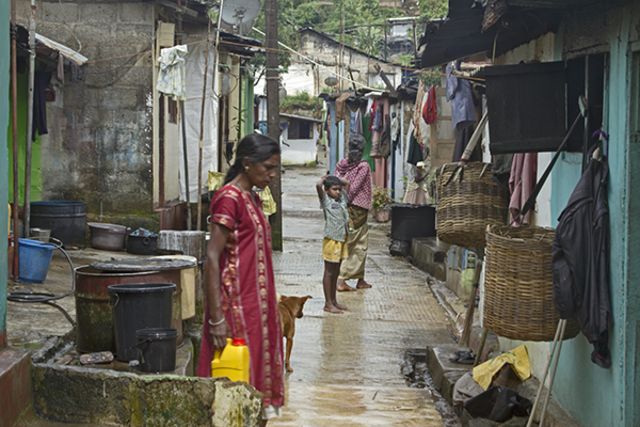By Meera Srinivasan/The Hindu
S.Indira Gandhi owns a brand-new house now. She is one of the first few from Sri Lanka’s hill country Tamil community – that has a two century-history in the island – who can call this home, and the piece of land beneath it, her own.
A full-time worker in a tea estate, the 33-year-old, along with her husband, is busy giving finishing touches to her cement-walled home in Dayagama, in Nuwara Eliya district in the Central Province. They have recently cut a path leading to the entrance of their home, where saplings bearing sprightly pink flowers pop up from either side. For the young couple, the home is much more than a secure place of residence, or a permanent dwelling.
From the time the British brought down hundreds of thousands of Tamils from South India in the 19 th.century to Sri Lanka, successive generations have been toiling in the country’s plantations. Even today, most of them live in colonial-era line rooms — closely packed match-box like dwellings on the hills — and many still work in the estates in difficult working conditions and with poor wages. Their story is better known as the global rise of the famed Ceylon Tea, a product that fetches precious foreign revenue, about $1.2 billion in 2016.
Following the transition from being stateless to becoming citizens in 2003, the ongoing change from being landless to owning a modest house on a small plot marks another significant shift for the community. Neither was an outcome of state benevolence. In fact, both followed persistent struggles by the nearly million-strong community and larger political dynamics.
Houses such as Indira Gandhi’s have been built by the Indian government as part of an initiative to construct 14,000 dwellings for Hill Country Tamils, to supplement the Sri Lankan government’s own efforts towards providing housing in the region. In an earlier project, India built 46,000 homes in the island’s Tamil-majority North and East for the war-displaced.
India aid Lauded
Malayaha (Hill Country) Tamils are quick to appreciate India’s attention to their community. As Tamils of most recent Indian origin here, they have been invisible not just to the Sri Lankan state, but also to New Delhi and Tamil Nadu for most part. Without doubt, they feel some affinity towards Tamil Nadu and India, through ancestral and cultural links. “My father gave me that name because I was born the day Indira Gandhi died,” says her namesake, smiling brightly.
All the same, many in her generation feel that the oft-used “Indian-origin” tag is both dated and distant.
“Even my national ID defines me as a ‘Sri Lankan estate worker’,” says her husband, K. Vijayakumar. “We are people of this country.” That is how they would like to frame their demands to the state – in the unmistakable voice of a rightful citizens, without tags that bear the baggage of uneasy histories.
In an apparent recognition of that emphatic voice, the Maithripala Sirisena-Ranil Wickremesinghe government put out an ambitious National Plan of Action for the social development of the plantation community, spanning five years beginning 2016. Among other initiatives, the plan envisions building 1,60,000 homes, financed partly with a government grant and the remaining with a 7.5% interest-loan. About 30,000 homes have been constructed so far.

For pensioner E. Sellappan, his new home in Hauteville Puram, built by the Minister of Upcountry New Villages, Estate Infrastructure and Community Development, is the only asset for his children. “This sonda veedu (own home) is the first recognition of my labor for my 36 years’ work at the estate,” he says.
The Road Ahead
The government points to its share of challenges. Despite a widespread campaign from workers for 20 perches land each, the government could manage only seven (about 2,000 square ft). “Finding land is our main challenge. The plantation companies are rather reluctant to part with productive land, or end up giving land that has no easy access to the main road,” says M. Vamadevan, an adviser to the Minister.
The gap between required resources and the actual allocations is also glaring. While the national action plan points to an estimated 15 billion Sri Lankan rupees investment in 2018 needed for the project – it will cost 70 billion rupees over five years – the annual allocation in the recent budget is only 2 billion rupees.
Housing is only one of the many long-ignored demands of the workers, who face historic neglect and exploitation. From education, to health to fair wages, many of their concerns remain unaddressed. “Even if wasps attack us, we have to put in our own money and get treated. Our struggle for a minimum wage of 1,000 (Sri Lankan) rupees earlier this year also failed after our political leaders signed a collective agreement with the companies. We are now stuck with 630 rupees a day,” says estate worker R. Pushparani, squinting her eyes against the glaring sun, while she rapidly plucks tea leaves with both hands.
In pointing out their current reality, she highlights the difference between a few workers owning homes, and all of them feeling at home.
































































